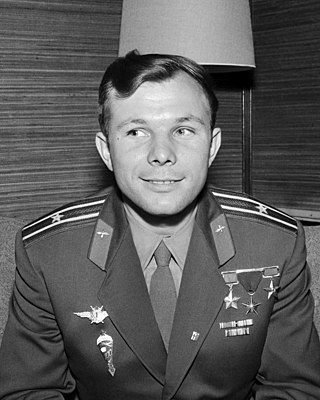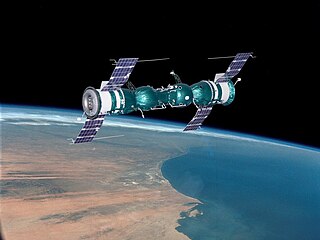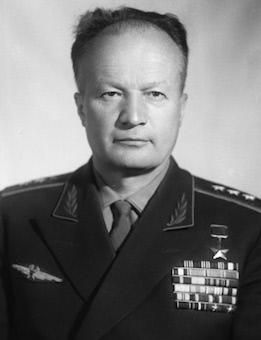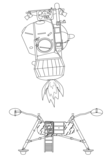
Yuri Alekseyevich Gagarin was a Soviet pilot and cosmonaut who, aboard the first successful crewed spaceflight, became the first human to journey into outer space. Travelling on Vostok 1, Gagarin completed one orbit of Earth on 12 April 1961. By achieving this major milestone for the Soviet Union amidst the Space Race, he became an international celebrity and was awarded many medals and titles, including the nation's highest distinction: Hero of the Soviet Union.

Vladimir Mikhaylovich Komarov was a Soviet test pilot, aerospace engineer, and cosmonaut. In October 1964, he commanded Voskhod 1, the first spaceflight to carry more than one crew member. He became the first Soviet cosmonaut to fly in space twice when he was selected as the solo pilot of Soyuz 1, its first crewed test flight. A parachute failure caused his Soyuz capsule to crash into the ground after re-entry on 24 April 1967, making him the first human to die in a space flight.

Soyuz 1 was a crewed spaceflight of the Soviet space program. Launched into orbit on 23 April 1967 carrying cosmonaut colonel Vladimir Komarov, Soyuz 1 was the first crewed flight of the Soyuz spacecraft. The flight was plagued with technical issues, and Komarov was killed when the descent module crashed into the ground due to a parachute failure. This was the first in-flight fatality in the history of spaceflight.

Soyuz 5 was a Soyuz mission using the Soyuz 7K-OK spacecraft launched by the Soviet Union on 15 January 1969, which docked with Soyuz 4 in orbit. It was the first docking of two crewed spacecraft of any nation, and the first transfer of crew from one space vehicle to another of any nation, the only time a transfer was accomplished with a space walk – two months before the United States Apollo 9 mission performed the first internal crew transfer.

Valery Fyodorovich Bykovsky was a Soviet cosmonaut who flew on three space flights: Vostok 5, Soyuz 22, and Soyuz 31. He was also backup for Vostok 3 and Soyuz 37.

Soyuz 4 was launched on 14 January 1969, carrying cosmonaut Vladimir Shatalov on his first flight. The aim of the mission was to dock with Soyuz 5, transfer two crew members from that spacecraft, and return to Earth. The previous Soyuz flight was also a docking attempt but failed for various reasons.

Boris Valentinovich Volynov is a Soviet cosmonaut who flew two space missions of the Soyuz programme: Soyuz 5, and Soyuz 21. Following the death of Alexei Leonov in October 2019, he is the last surviving member of the original group of cosmonauts. He is also considered to be the first Jew in space.

Valery Nikolaevich Kubasov was a Soviet/Russian cosmonaut who flew on two missions in the Soyuz programme as a flight engineer: Soyuz 6 and Soyuz 19, and commanded Soyuz 36 in the Intercosmos programme. On 21 July 1975, the Soyuz 7K-TM module used for ASTP landed in Kazakhstan at 5:51 p.m. and Kubasov was the first to exit the craft. Kubasov performed the first welding experiments in space, along with Georgy Shonin.

Soyuz 9 was a June, 1970, Soviet crewed space flight. The two-man crew of Andriyan Nikolayev and Vitaly Sevastyanov broke the five-year-old space endurance record held by Gemini 7, with their nearly 18-day flight. The mission paved the way for the Salyut space station missions, investigating the effects of long-term weightlessness on crew, and evaluating the work that the cosmonauts could do in orbit, individually and as a team. It was also the last flight of the first-generation Soyuz 7K-OK spacecraft, as well as the first crewed space launch to be conducted at night. In 1970, Soyuz 9 marks the longest crewed flight by a solo spacecraft.

The Vostok programme was a Soviet human spaceflight project to put the first Soviet citizens into low Earth orbit and return them safely. Competing with the United States Project Mercury, it succeeded in placing the first human into space, Yuri Gagarin, in a single orbit in Vostok 1 on April 12, 1961. The Vostok capsule was developed from the Zenit spy satellite project, and its launch vehicle was adapted from the existing R-7 Semyorka intercontinental ballistic missile (ICBM) design. The name "Vostok" was treated as classified information until Gagarin's flight was first publicly disclosed to the world press.
Soyuz 35 was a 1980 Soviet crewed space flight to the Salyut 6 space station. It was the 10th mission to and eighth successful docking at the orbiting facility. The Soyuz 35 crew were the fourth long-duration crew to man the space station.

Soyuz 36 was a 1980 Soviet crewed space flight to the Salyut 6 space station. It was the 11th mission to and ninth successful docking at the orbiting facility. The Soyuz 36 crew were the first to visit the long-duration Soyuz 35 resident crew.
The Soviet crewed lunar programs were a series of programs pursued by the Soviet Union to land humans on the Moon, in competition with the United States Apollo program. The Soviet government publicly denied participating in such a competition, but secretly pursued two programs in the 1960s: crewed lunar flyby missions using Soyuz 7K-L1 (Zond) spacecraft launched with the Proton-K rocket, and a crewed lunar landing using Soyuz 7K-LOK and LK spacecraft launched with the N1 rocket. Following the dual American successes of the first crewed lunar orbit on 24–25 December 1968 and the first Moon landing on July 20, 1969, and a series of catastrophic N1 failures, both Soviet programs were eventually brought to an end. The Proton-based Zond program was canceled in 1970, and the N1-L3 program was de facto terminated in 1974 and officially canceled in 1976. Soviet cosmonauts never orbited nor landed on the Moon. Details of both Soviet programs were kept secret until 1990 when the government allowed them to be published under the policy of glasnost.

Nikolai Petrovich Kamanin was a Soviet Air Force general and a program manager in the Soviet space program. A career aviator, he awarded the title of Hero of the Soviet Union in 1934 for the rescue of SS Chelyuskin crew from an improvised airfield on the frozen surface of the Chukchi Sea near Kolyuchin Island.
Valentina Leonidovna Ponomaryova is a former Soviet cosmonaut, pilot and scientist.

Soyuz 7K-OK was the first generation of Soyuz spacecraft and was flown between 1967 and 1971. The 7K-OK was used for the first ferry flights to the Salyut space station program, beginning a long history of space station service that continues today with the International Space Station (ISS).

DOS-2 was a space station, launched as part of the Salyut programme, which was lost in a launch failure on 29 July 1972, when the failure of the second stage of its Proton-K launch vehicle prevented the station from achieving orbit. It instead fell into the Pacific Ocean. The station, which would have been given the designation Salyut 2 had it reached orbit, was structurally identical to Salyut 1, as it had been assembled as a backup unit for that station. Four teams of cosmonauts were formed to crew the station, of which two would have flown:

The honorary title Pilot-Cosmonaut of the USSR was a state award of the Soviet Union presented to all cosmonauts who flew for the Soviet Space Agency. Usually accompanying the distinction was the title of Hero of the Soviet Union, the highest title that could be awarded to a Soviet citizen for performing heroic deeds while in service of the state.

Vostok 3 and Vostok 4 were Soviet space program flights in August 1962, intended to determine the ability of the human body to function in conditions of weightlessness, test the ground control capability to launch and manage two separate, concurrent flights, and test the endurance of the Vostok 3KA spacecraft over longer flights. Cosmonaut Andriyan Nikolayev orbited the Earth 64 times in Vostok 3 over nearly four days in space, August 11–15, 1962, a feat which would not be matched by NASA until the Gemini program (1965–1966). Pavel Popovich was launched on Vostok 4 on August 12, and made 48 Earth orbits. The two capsules were launched on trajectories that brought the spacecraft within approximately 6.5 km (4.0 mi) of each another.

The Roscosmos Cosmonaut Corps is a unit of the Russia's Roscosmos State Corporation that selects, trains, and provides astronauts as crew members for the Russian Federation and international space missions. It is part of the Yuri Gagarin Cosmonaut Training Center, based at Star City in Moscow Oblast, Russia.
















